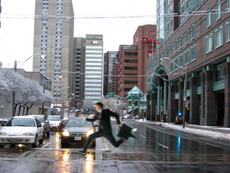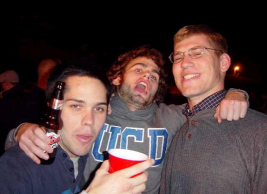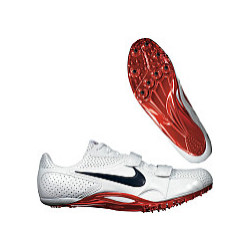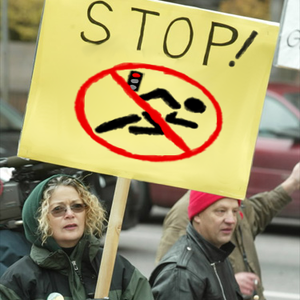User:Staircase/Running a Red Light
Originally a fun game drunk friends played on Saturday nights, Running a Red Light is now a popular professional sport admired for the courage of the participants. What was a friendly and gruesome game between friends has evolved into a full-fledged professional sport, with coaches, high-tech equipment, and tons of loving fans. All of the athletes have to go through an intense work out regimen; otherwise they could not make it to the professional level, and, hopefully, to Red Light Cup. Only the best of the best make it, and, quite frankly, they are the only ones who survive. However, the title of "Grand Runner" is worth the peril they face.
Development[edit | edit source]
Before the creation of the game, Running a Red Light was an illegal activity usually done by vehicles. However, after one Saturday night in Portland, Oregon, that all changed.
It all began with three men - Jerry Smith, Ian Thompson, and Samuel Cook - who were out for an occasion at the local bar, Grizzly Man Pub. The three, who had just a few too many drinks, decided that they should do some sort of activiy that would entertain them until they all passed out from over-consumption of alcohol. After roughly thirty minutes of thinking, all three produced no sensible ideas.
"We were all stumped. But then it came to me," Said Jerry, the creator of Running a Red Light. "On the way to the pub, I had remembered that I had run a red light. I was sort of stumbled as to why they called it 'running' a red light, as opposed to 'driving' or 'crossing'. So, in an act of drunkenness,
I decided to take it just a bit too literally." After Jerry announced his new idea to his buddies, all three romped out of the pub and approached the nearest intersection. Jerry, the creator of the game, declared that he would go first as an example for the other two, Ian and Sam. He walked calmly, despite being drunk, into the middle of the road. Cars zoomed passed him and honked as they did so, with the occasional driver giving him an impolite hand gesture. Then, the light turned red and cars began crossing the intersection. Jerry, determined to succeed, ran across, stopping, swerving, staring into head lights, and causing many people to honk loudly. However, despite all of the trouble he caused, he made it across the intersection alive.
Up next was Ian. "It was really sort of gruesome," said Samuel, a friend of Jerry and Ian. "I mean, there were quite a few cars going across the road at the time... and guess Ian just had one too many drinks. After the first car hit him, he flied into the next lane, where two cars used him as a speed bump. His guts flew everywhere. I mean, it was disturbing, but Jerry and I couldn't hold ourselves from saying 'AWESOME!'" After Ian's failure of an attempt, several people called the Police, and both Jerry and Samuel were arrested.
However, after the two men were arrested and the pieces of Ian's body were collected, the event hit the newspapers. Some papers called it "Human Frogger", and others called it "Suicide". However, despite harsh criticism in the articles, a surge in popularity began. People all across the country began sprinting and weaving through busy intersections. Soon enough, so many people were doing it; police just left it alone whenever "Mad blokes running across the way." was reported. And, with so many people beginning to participate, leagues of teams began to form.
Running a Red Light as a Sport[edit | edit source]
After an extreme increase in popularity, small leagues of men, many of whom sober and clear minded, began to form. The first and most famous amateur league was called "Portland County Red Light League", or "PCRLL" to many. The league of roughly twenty men met every Saturday evening to begin the games.
The rules were simple. Each man would run across the road as cars were going by, and whoever made it across alive would get a free beer after the games were over. For those who didn't they just said "Better luck next time, pal." This continued for several weeks, each week several more men joining and joining. Soon enough, the league became so big that it was split into three sections: Portland County Red Light Beginner League, which was for new, less experienced participants, Portland County Red Light Intermediate League, for users who had a decent amount of experience but were not the best they could be, and Portland County Red Light Expert League, for the true masters of sprinting across the roads. And, after this split, leagues began forming in other surrounding cities, and eventually they began showing up around the country.
At this point, both Jerry and Sam had been released from jail. Jerry, who became very famous, accepted the job as the commissioner of the PCRLL.
Equipment[edit | edit source]
To properly participate in the Red Light Running, you need a certain amount of equipment. Without this equipment, attempts to play the sport can go horribly wrong, resulting in death, concussion, major injury, and scratched knees. Some of these pieces of equipment are cheap, basic, and generally easy to find, while other can be very expensive and rare. It is very important that participants acquire all of the equipment, otherwise results will be disastrous.
There are three necessary pieces of equipment to successfully run a red light. The first, and probably most important, are good running shoes. If you do not have good running shoes, you are putting your life at risk. One participant, Charles Barnes, had an unfortunate case in which he had poor running shoes. "I thought I would be fine, running into the road with thongs on. And no, not the underwear, the shoes. Like um... 'Flip-flops'. So, I was wearing those, and when I sprinted into the road, one of them fell off. The road was hot because the sun was out, so I tried to go back and get it so my feet wouldn't burn," said Barnes. "But then I got hit by a Honda Civic. That's why I'm missing an arm!"
Apart from quality shoes, it is also recommended that competitors bring a set of clothing along with them. Those who run without clothing have a greater chance of getting arrested for streaking instead of jaywalking, which is less severe than running around nude in public. Also, along with your shoes and clothing, it is required that you bring a body bag, just in case you do not make it alive.
Practicing[edit | edit source]
Practicing running red lights is a physically demanding activity, for so is the sport itself. To be a successful red light runner, one must have a good amount of agility, speed, and awareness. If the person lacks any of these qualities, death could await them.
Most amateur or new players begin practicing in specialized rooms. These rooms have foam models of cars moving across the room in a randomized pattern, and the players must run across without getting knocked over. If they do, they must try again until they do make it. Some, more dedicated players hire professional trainers to guide them in playing the game. These trainers train the recruits in all aspects of the sport, including agility, where they make them sprint through corn field mazes, speed, by having a hungry tiger chasing them, and awareness, by taking them to shooting galleries. However, despite being very helpful, these trainers are often very expensive. Those who have success with these trainers say it is well worth the price, while others say their trainer hardly helped them.
Hazards[edit | edit source]
Similar to Water Polo... With Sharks!, Running a Red Light, despite being very popular and entertaining, has a series of hazards. All players who have joined a league have to sign contract signifying that they know the dangers of Running a Red Light. Many sign the contract without reading it, and therefore do not realize they cannot sue for their injuries until it is too late.
Running a Red Light has several hazards. The first, and probably most noted, is death. First off, running into a street is NOT a good idea, especially when the street is full of cars going at speeds over thirty miles an hour. Being hit by one of these cars could lead to death, or the second most noted hazard, serious injury. If the participant somehow survives being hit by a car, the league is protected from lawsuit by its contract. Also, if the participant dies, the league is still protected, because family members agreed not to file a law suit if such results occur.
Other hazards that can occur from the sport include: minor cuts and scratches, arrest, and, in some cases, lawsuit from drivers who had their car damaged in an accident.
The Professional Red Light Running League[edit | edit source]
Soon, once the popularizing sport spread all the way across the United States, it was decided that a professional league should be created. Meetings were held by a group of eager people who were ready to begin making the league. Among these people were Jerry and Samuel. After a few months, the league's name was chosen and preparations began. The league, called The Professional Red Light Running League, was gaining large amounts of members at a rapid pace. However, since the old game operated with simple rules, the rules of the professional level had to be revised to make a more fitting, clear, and precise set of guidelines.
Rules[edit | edit source]
A series of sixty-four teams are to exist in the professional league. In a bracket formation, each team goes up against other teams, and for each win, the team advances up in the bracket, hopefully to the final round. This is called one "Tournament". Each tournament has one winner. For every tournament a team wins, it is kept in a tally. There are thirty-two tournaments in one season.
Within a tournament, a single team of ten men has to go through six rounds to win. In each round, the two teams compete. In order to compete, both teams send one representative at a time to attempt to cross the street. Both, one from one team and one from the other, go simultaneously across the road. If one makes it, it is a point for that team. If one does not, no points are tallied. Whoever scores the most points out of ten in the end wins, and moves on to the next round. If there is a draw, sudden death is to be called for. In a round of sudden death, each team chooses one representative to go up against the other team in a Highway Battle, where the two must cross a fast-moving highway. Whoever succeeds is the winner. If both succeed, or if neither succeed, two new representatives are called for until a victor is decided.
The teams follow this process through every round of the tournament, and, eventually, a winner is decided. At the end of the season, the four teams with the most tournament wins move on to the post season where they begin the well known "Grand Tournament". Whoever wins this tournament is crowned "Grand Runner".
From outside the game, the league has a distinct set of guidelines:
- Any user caught using performance enhancing drugs shall be promptly removed; preferably by being thrown into the road shackled at the legs.
- Any player/team caught cheating will be automatically disqualified, allowing the other team to win and advance.
- Alcohol and controlled substances are allowed and encouraged for the enjoyment of the audience.
- All players are to participate unless injured or killed.
- If a player has any body part severed, the remains are to be left alone.
The guidelines, though controversial, are still used today. Since there is such a small set of rules, this allows players to do many things other sports would not allow. However, usually these things are for the good of the game, and are given positive feedback.
Controversy[edit | edit source]
However, despite the game's extreme and growing popularity, it still has a very large amount of criticism facing it.
Every year the league takes several hundred lawsuits, but manages to invalidate them with their signed contracts or win them with good lawyers. Apart from that, the league constantly gets negative publicity and the press has released several articles explain how dangerous and stupid the league is.
The most commonly used form of criticism is that of Running a Red Light-related death. The death toll, after about two years, had reached an astounding amount of some 2,000 lives taken, with another 3,000 injured. These facts are the cause of most major lawsuits; however, these are usually lost or invalidated. These facts also draw the most criticism from skeptics, who warn people of the dangers of the game. However, many people have disregarded the skeptics and continued playing the sport, and, usually, ended up dying.
"It's really quite outrageous," says Running a Red Light critic, Adam Wats. "These guys put their lives on the line... for what? What is the reward in this? There is no money, and it is nothing to really be proud of. So why do it? Let me tell you, running across the street like a madman doesn't attract the ladies." Other ctitics have also spoken regarding the subject, namely overly-concerned and protective parents. "I don't want my child to do this when they are growing up," says one parent. "It's just crazy that peple would do this. I want my children to be safe from such crazy... ness? And that's why I took the TV and internet away, as well as electricity altogether. And, because of this, we're all going to move to Pennsylvania to join the Amish." In some cases, groups of activists such as concerned parents and confused people have formed to strike the league and to try and diminish it altogether. However, these groups of picketers have made no effect on the league, which still gained users rapidly.
Today, the sport is gaining members rapidly, despite the criticism surrounding it. The death toll is steadily increasing; however, eager people still join the league for a thrill or an attempt at glory.



